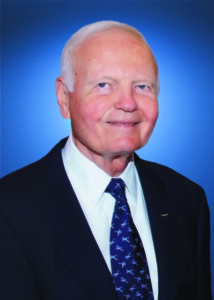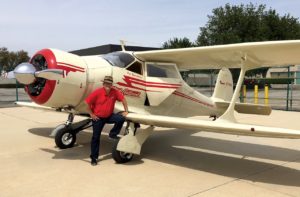Category Archives: Industry
October 12, 2018
Bruce spent virtually his entire career, which spanned over 60 years, with one company—FlightSafety, International. He used to joke that he had only one promotion during that tenure, and it took 43 years to get it! That’s because he became the “right hand man” to the firm’s founder, Al Ueltschi, very early in his tenure and only moved up after Mr. Ueltschi passed away in 2003. It’s tough to get promoted when you’re #2 to the company’s founder, who worked until he was 96. There just aren’t a lot of jobs to choose from in that situation!
 Bruce Whitman spent his life minding his “P’s and Q’s.” He was Precocious, Persistent, Patriotic, Powerful…and Polite. No one in business aviation was ever nicer, more deferential or sensitive to the people with whom he worked than Bruce. He treated us all the same—extremely well. The number of people who can rightly call him their “friend” is legion, and he really did care about all of us. If you look up “gentleman” in the dictionary his picture may not be there, but the definition is his biography!
Bruce Whitman spent his life minding his “P’s and Q’s.” He was Precocious, Persistent, Patriotic, Powerful…and Polite. No one in business aviation was ever nicer, more deferential or sensitive to the people with whom he worked than Bruce. He treated us all the same—extremely well. The number of people who can rightly call him their “friend” is legion, and he really did care about all of us. If you look up “gentleman” in the dictionary his picture may not be there, but the definition is his biography!Bruce must have always been precocious because he succeeded at everything he did…and ended up holding important positions of leadership as a student, Air Force officer, and businessman. As a 24 year old he managed to earn ratings as an Air Force pilot, navigator and bombardier and capped that off by being appointed Assistant to the Commander of Homestead Air Force Base. It’s obvious it never took long for Bruce’s talent and acumen to get noticed.
His persistence carried over from his time as an athlete, student and serviceman to his professional career. After a brief stint as an executive at NBAA, he began his tenure with FlightSafety in 1961. Even though it was already impressive, he never had to update his resume again. He and FlightSafety were inseparable. After Mr. Ueltschi died, Bruce and FSI became synonymous. His grace, strength of character and leadership characterize the organization he led for the past 25 years.
When the persistent Mr. Whitman got involved in something, he made it his mission to ensure its success. A look at the long list of organizations he served as a board member, chairman or advisor underscores his dedication and leadership. An obvious example—one of many—is his chairmanship of the Congressional Medal of Honor Foundation. Bruce’s patriotism, exhibited by his own service in both the Merchant Marine and the Air Force, was a driving force in leading the Foundation’s initiatives in Character Development, scholarship programs, exhibits and multimedia projects aimed at increasing awareness of the Medal of Honor and what it represents.
Bruce would probably shy away from the term “powerful” as a description of him, but he certainly possessed a powerful intellect, a potent influence on others, and highly effective ability to negotiate and implement his initiatives. He was deferential to a fault and demonstrated genuine humility, but he was deservedly respected for his leadership and unwavering example.
Bruce Whitman definitely embodied those five “P’s”. But he didn’t ignore the “Q” when it came to “minding his P’s and Q’s.” Bruce lived a life of Quality. He leaves a legacy of quality in the way he dealt with others, in the level of work he performed and in the example he provided to those he befriended and mentored.
In a world that is increasingly political, he was polite. While confusion reigns regarding this country’s place in the world, he was patriotic. Where change for the sake of change is perceived as the path to success, he was loyal and persistent. As impatience for advancement has become rampant, his precocious talent proved to be especially valuable to every organization he served, and where power at all costs has become a goal, Bruce’s powerful presence and personal humility offer a far better example of true success. His was a Quality life and it improved the quality of all the lives he touched, as well.
June 25, 2018
Mid-Continent Instruments and Avionics is honoring the memory of Pat Napolitano – pilot, A&P Mechanic and friend, by funding the establishment of The Pat Napolitano Memorial Scholarship for Aspiring Technicians. Through this scholarship, Pat’s legacy will inspire a new generation of aviators.
Pat Napolitano, Fleet Support Representative and Staggerwing Pilot for Mid-Continent Instruments and Avionics, passed away in an airplane accident May 25, 2018. Having been with the company for more than 15 years, Napolitano was a respected employee and member of the aviation community. With more than 30 years of experience and over 4,500 hours of flight time, his passion for aircraft maintenance and flying was apparent to anyone who had the opportunity to meet him.
“I am personally saddened to lose a close friend and colleague,” said Todd Winter, President and CEO of Mid-Continent Instruments and Avionics. “Pat’s love for aviation was contagious. He was a passionate and caring person; an impressive pilot and technical expert. He helped make flying fun. We will miss him greatly and remember him every time we fly.”
The Pat Napolitano Memorial Scholarship for Aspiring Technicians is available to all graduating seniors or current college students pursuing their Aviation Technician Certification.
Mid-Continent Instruments and Avionics has partnered with the Aircraft Electronics Association (AEA) Educational Foundation to administer the scholarship program.
Donations to the Pat Napolitano Memorial Scholarship can be made to:
AEA Educational Foundation
c/o Pat Napolitano Memorial Scholarship
3570 NE Ralph Powell Rd.
Lee’s Summit, MO 64064
For more information about the scholarship, contact Julie Lowrance, Director of Communications for Mid-Continent Instruments and Avionics, at 316.630.0101.
September 19, 2017
By: Nate Franson
The general aviation market is experiencing a bit of a labor crisis. Fewer and fewer new pilots are being trained, and part of the reason for the decrease in student starts is the lack of options when it comes to places, aircraft, and instructors with whom to learn to fly. Fewer airports and FBOs offer two- or four-place pistons for rental, and many no longer have any flight instructors on staff. Those that do typically have 1970s-era aircraft like the venerable Cessna 172 – a fine aircraft, of course, but usually equipped with avionics that came out about the same time as the Atari 2600.
Further complicating the issue is the cost of instruction – an hour of flight time can start around $150, and that’s not even taking into account materials and ground school. The newer aircraft on which prospective pilots typically would like to be trained – like Textron’s updated Model 172 Skyhawk with full glass panels and ADS-B — are currently retailing near half a million dollars. That’s quite the jumping-on point, financially, especially in a depressed flight instruction market.
A final wrinkle in the situation is the dwindling accessibility of 100 LL fuel, a specter that has been looming on the GA horizon for some years now. Almost all training aircraft run on it, so if it disappears completely, chaos would likely ensue as flight schools sought to modify or replace their fleets.
All of these factors conspire to lead us to a point in the not-too-distant future where the population of pilots is not only shrinking, but also aging and flying with far less frequency, just like the planes used to train them. The instruction market is saturated with aircraft over 30 years old, typically toting avionics from the same era that won’t meet looming Next-Gen ATC system requirements , and the newer, updated models of appropriate aircraft from tried-and-true manufacturers cost more than a house.
Fortunately, there are a lot of those older airplanes out there. They were built to last – basically forever, as long as they were maintained according to company guidelines and government mandates. While maintenance costs money, and updates cost more, the good news they don’t cost more than a house. With a little collaborative ingenuity, this fleet could be used to spur a revival not only in instruction, but also the recreational segment of the small plane market.
The AOPA is touting plans for such collaboration between owners and operators of these aircraft, forming flying clubs and co-owning planes to encourage both newcomers and lapsed operators turned off by the increasing expense and time investment needed. The EAA has spearheaded a push to get the FAA to grant “driver’s license medicals” which allow those certified beyond Sport Pilot to fly GA aircraft with clearly defined limitations without the need for an FAA medical. Other GA organizations are supportive, but will need to come together in pursuit of the common goal of reinvigorating general aviation and encouraging new students.
The current trend in GA is leading us inexorably towards a future without enough pilots to service the demands of the industry. As technology advances, the need or desire to fly could be eclipsed by more cost-effective or otherwise appealing means. In the interest of reviving a great pastime and revitalizing a downtrodden market—or even spurring some innovative new usage, those of us in the aviation community will need to work together to carry small aircraft flying into the next era.
October 31, 2016
The 37th Annual Kansas Economic Outlook Conference took place on October 6, 2016.
About the CEDBR.
The mission of the Center for Economic Development and Business Research (CEDBR) is to enhance the region’s economic growth and development by:collecting, analyzing and disseminating business, economic and demographic information
conducting applied business, economic and demographic research
serving as a vital link between the business and economic development community, Wichita State University and the W. Frank Barton School of Business.
The CEDBR strives to be recognized by the business and economic development community as: a reliable and responsive source for business, economic and demographic information, and as an essential partner in the region’s economic development process by conducting high-quality, objective research on issues related to the community’s current and future economic well-being.
Thanks to WSU TV for producing this video!

